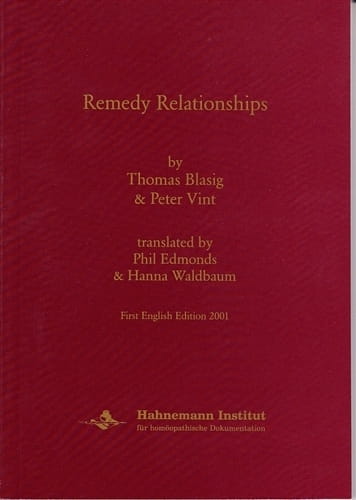This book contains information on complementary remedies, sequences of remedies, related bowel nosodes, antidotes and inimicals. ". . .Special effort has been made to have any comments related to the oldest available source and to state - wherever possible - whether we were talking about the homeopathic remedy (e.g. Coffea) or the "crude substance" (e.g. coffee)." Thomas Blasig, from the Preface.
'I first saw this book in Belgium in 1998, and immediately thought, we would like that in English. It was so nicely produced, and remembered how I had carried around my dog eared Indian Print of the remedy relationships book, so treasured for years. I thought, this is better! I asked the publisher, Reinhard Rose, how could we get the book in English. You can translate it, it is not much, look, most of it is just remedy names in Latin. I saw that it was not a huge task, and contacted my friend and colleague, Hanna Waldbaum, who said she would be interested in collaborating with me over the translation. We underestimated the amount of time involved, by about 80%, so here 3 years later, after fitting in a few hours here, a few hours there, is the result. It was worth it! Kind thanks to Peter Vint in Germany, for supplying the original texts, and his expertise in recognising where for example the source is Clarke, that the original English text has been used, rather than retranslated German! Enjoy the book, and more power to Homoeopathy'. Phil Edmonds July 2001
Reprinted with the permission of The Society of Homeopaths, (from "The Homeopath" Journal July 2002 edition). Reviewed by Andrew Ovenden.
I think that many homeopaths have an ambivalent attitude to remedy relationships. At least one eminent prescriber whose opinions I usually respect, gave a one word answer when asked about remedy relationships which would lead one to believe that he has absolutely no time for the subject. However, I believe there cannot be many of us who have not at some time pored over the 'Relations' section of Clarke's Materia Medica during a consultation, wondering if it really is okay to give Sulphur after Calcarea carbonica.
Also, you may have considered the relationships of remedies to each other, in order to decide if the acute medicine we are prescribing may interfere with the patient's constitutional treatment. This is often a perplexing and frustrating rise due to various inconsistencies in the information and, in my case, an underlying nagging doubt about the validity of the concept of relationship of remedies. The idea of one medicine negating another due to their similarity seems fairly clear-cut, but the concept of remedies that are 'complementary' to each other, or remedies that 'follow well' always seems a little dubious. Surely, any remedy can 'follow well' or be 'complementary', depending on the individual circumstances.
My first impressions of this book, however, were favourable, particularly when compared to my battered copy of Drug Relationship by Calvin B. Knerr (1951 edition), which, like other similar books I have owned, is set out in a tabular form, and which I find both irritating and difficult to use. This volume is clearly laid out in alphabetical order, with categories for antidotes, complementary remedies, remedy cycles, and inimical remedies. The bowel nosodes are also included.
For those of you worried about space on your already groaning bookshelves this volume is usefully smaller than the aforementioned Knerr. The informative preface explains that all the sources are clearly referenced, and a lot of care has been given to correcting errors, omissions and misquotes from previous books on remedy relationships. A feature I particularly applauded was that all rubrics are complete in themselves, i.e. information concerning two related remedies is given under both remedy-headings. This saves us valuable time which we might otherwise have spent looking the relationship up from both 'directions'; and indeed, in many cases, finding contradictory information!
Another advance on previous works of this type is the very sensible omission of the 'Emphasis' and 'Follows Well' categories. This is because various authors often do not agree on these remedies, or worse still, that the information is based on one case, which has then been repeatedly copied over the years.
In conclusion, while many of us may still have doubts about the use of remedy relationships, this book is a useful advance over previous texts in this area, and it will make those occasions when I want to refer to remedy relationships less frustrating. Thus, it will certainly replace Knerr on my bookshelf, even if I do not refer to it very frequently.

